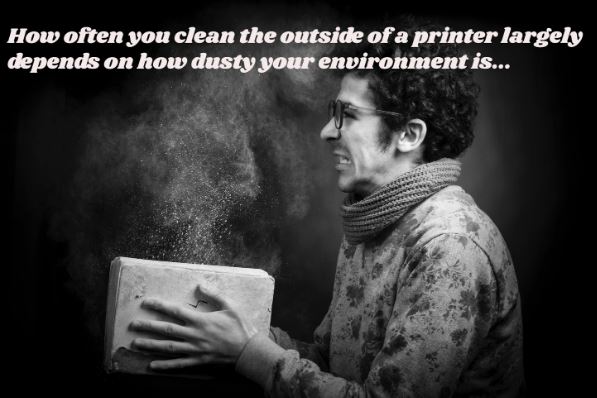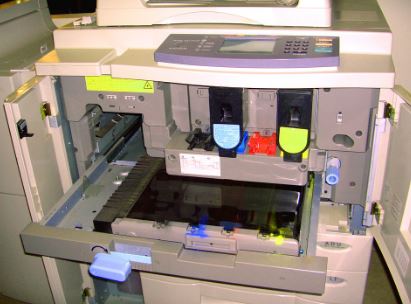How to clean printer yourself: Simple and easy tips
Posted on Thursday 03 January, 2019

Keeping your printer clean isn't merely a cosmetic issue. Avoiding a buildup of debris can help avoid problems.
Outside
How often you clean the outside of a printer largely depends on how dusty your environment is. Another consideration is that dust on a gloss black case is all too obvious, while it's almost invisible on a matte beige finish.
Our number one tip is to follow the instructions! If you've mislaid the manual, it's usually available for download from the manufacturer's site - if you struggle to find it, Google is your friend. The manufacturer knows more about the materials used in the printer than you do, and using any solvent or cleaning material not specifically recommended by the manufacturer is taking a big risk.
In our experience, the typical recommendation is to use a soft damp cloth. That's damp, not wet! You don't want water finding its way inside the case, so make sure all covers and flaps are closed before you begin. This also helps prevent the cloth snagging on exposed corners and potentially breaking small parts such as flaps and guides.
Inside
Recommendations vary about how often the inside of a printer needs cleaning. We've seen "several times a year" as a guide, which doesn't seem excessive. If you've opened the cover to replace ink or toner, or to deal with any other problem, take the opportunity to see how clean the inside is. If you think it needs cleaning, get on and do it.
At the risk of sounding like a parrot, read and follow the manufacturer's instructions. For example, it may be appropriate to wipe off any ink overspray with a soft dry cloth, but there may be parts of the printer where the risk of mechanical damage is so high that the ink will probably do less damage than any attempt to clean it.
Use compressed air to clean
Dust and paper fibres accumulate inside a printer, potentially causing misfeeds. Compressed air is sometimes recommended (including by some manufacturers) as a way of clearing it out, but there are said to be at least two problems. One is that it may introduce moisture to the mechanism and circuitry; the other is that if used carelessly the force of the jet can physically damage delicate components. So use it with care, even the "air duster" maker explicitly says it is suitable for cleaning printers.
Depending on the exact design of the printer, it may be possible to remove most or all of the dust by gently using a soft brush and a dry, lint-free cloth.
Take particular care when cleaning laser printers. According to some sources, skin contact with toner or inhaling it may pose health risks. However, Fuji Xerox (for example) states that its toners "do not contain hazardous substances according to Worksafe Australia and are not considered as hazardous preparations according to any regulatory classification criteria."
But the company adds "It is possible however if toner dust is breathed indirectly, that it could irritate the respiratory tract." So consider wearing a suitable dust mask when working inside a laser printer.
Avoid stirring up toner dust - don't use compressed air, and don't blow into the mechanism - though that would be difficult if you were wearing a mask...
You might be tempted to use a vacuum cleaner, but
-
a) there's an (arguably slight) risk of static buildup damaging the printer's electronics
-
b) many vacuums cannot trap particles as fine as toner powder, potentially leading to damage to the vacuum and the loose toner being dispersed into the air.
Both issues are dealt with by using a vacuum specifically designed to pick up toner, but they are expensive ($400 or more).
Buy Toner cloth to clean the toner cartridges
Toner cloth is specifically designed to catch and hold toner. It's not the easiest product to find in Australia, though the Tonerclene brand is available from some outlets. Purchasing other brands from overseas can be expensive (eg, a bulk pack of 400 cloths from another manufacturer that sells for less than $US100 can cost more than $300 delivered to Australia).
Disposable gloves are a good idea when cleaningprinters cartridges because you can peel them off as soon as you've finished the job. That reduces the risk of transferring ink or toner to your clothing before you can wash your hands. If you do get toner on your clothes, shake off as much as you can and then be sure to wash them in cold water so any remaining toner doesn't set on the fabric.
Various rollers within the printer may need cleaning for reliable paper feeding. Lint-free cloths or cotton buds are typically recommended, dampened with water or isopropyl alcohol. You know what we're going to say next, don't you? Yes, follow the printer manufacturer's instructions.
The same goes for cleaning other internal components. For example, some laser mechanisms have a built-in tool for cleaning the corona wire, but others require the use of a cotton bud. It's generally not recommended to clean the photosensitive drum "just in case," but it is appropriate if you have traced a printing problem to a dirty drum. Again, a cotton bud - normally dry - is often the way to go.
You may come across cleaning sheets that purport to pick up the crud that accumulates along a printer's paper path. Some people find they give good results, others say they are a waste of money, especially if they jam inside the printer. It's worth noting that some manufacturers specifically advise against their use.
One area that usually does require a liquid cleaner is the document glass of a multifunction device. The image is captured through this glass, so any dust or smudges will show up in the resulting file. Wiping the glass with a clean, soft, lint-free cloth (eg, microfibre) is a good start. NB: press lightly, or you may break the glass.
If that doesn't do the job, then In the absence of a specific recommendation from the manufacturer, spectacle cleaner is a fairly safe choice and usually has antistatic properties to reduce dust attraction. Dampen a clean, lint-free cloth with the cleaner and wipe gently. Spraying cleaner directly onto the glass is a bad move because it can result in liquid dripping into the device.
While only a small amount of cleaner is needed each time, you'll need to clean the glass frequently if you care about scan quality, in which case a small bottle (30 or 60ml) won't last long. Larger sizes (250ml or so) are usually much more economical.
Some people swear by proprietary glass cleaners such as Windex, but formulations that include ammonia may be problematic.
You'll sometimes need to clean the underside of the scanner glass. Dirt on that surface can result from use in a particularly dusty environment, but if the surface appears foggy we suspect that a factor is outgassing from plastic components, much as happens to the inside surfaces of car windows.
Getting at the underside of the scanner glass can be tricky, and usually involves removing the scanner cover and then the top case. That may be as simple as removing a few screws, or it can be a more involved process. Someone may have worked out how to do the job and taken the trouble to document it for you, and a search along the lines of clean hp laserjet 3030 scanner glass may locate their instructions.
If your multifunction has an automatic document feed, don't forget to clean the thin strip of glass covering that part of the mechanism.
The white plastic surfaces on the underside of the scanner lid may also need cleaning, usually with a clean, soft, lint-free cloth moistened with water.
You may have noticed we haven't mentioned cleaning inkjet printheads - that's a subject for another time.








Any comments?